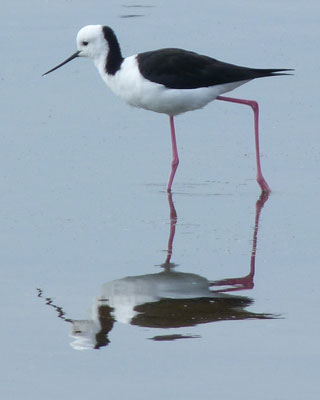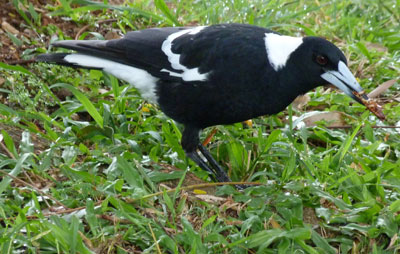Birds abound on Australia’s east coast
This article appears on page 50 of the March 2013 issue.
by Wendy Schatz — Bellevue, WA
Growing up in Australia, I paid no more attention than any other child to the local birds. But a 2012 return visit with some American bird-watching friends let me see what was once common through their fresh eyes, and I liked what I saw.
Not only does Australia have some of the most spectacular birds in the world, but the southeast corner of Queensland has such diverse habitat that it is one of Australia’s birding hot spots — all within a day’s drive of Brisbane.
I own a US travel agency and return to Australia twice a year to keep up to date. Showing my friends around, I realized many independent travelers could do on their own the same thing we were doing and enjoy it.
Coastal birding
My friends joined me and my husband in Brisbane in May — fall in Australia and a pleasant time to visit. I had a small advantage over them because I grew up there, but my visitors had a copy of Simpson & Day’s “Field Guide to the Birds of Australia” plus binoculars and sharp eyes, all standard equipment for bird-watchers.
Just walking around our tree-lined neighborhood on their first day, they identified a dozen birds, including the kookaburra and willy wagtail. To see what else we might discover, we decided to head to the ocean.
One of the best places for coastal bird-watching is relatively undeveloped North Stradbroke Island. We booked the car ferry (phone 07 3488 5300) from Cleveland, on the eastern edge of Brisbane, across the bay to Dunwich, on the island. You could also walk onto the ferry and catch the local bus at Dunwich.
Point Lookout, our destination, is on the other (eastern) side of “Straddie,” as the locals call it, 25 kilometers from Dunwich. Straddie is one of those offshore sand islands that separate Moreton Bay from the South Pacific Ocean.
Trails from Point Danger took us out onto the shrub-covered headland. Banksia bushes that thrive in the salt air were full of honeyeaters, birds that are as common to Australia as sparrows are to America. Their throaty calls could be heard everywhere.
As we scanned the sea for migrating whales from a panoramic point, terns and gulls wheeled below us in the ocean spray. We climbed down to the beach at Frenchmans Bay, walked barefoot across the sand and watched shorebirds scoot along at the water’s edge as if they were on ball bearings.
On our way back to the ferry we spotted a wedge-tailed eagle soaring above a ridgeline. The massive wedge-tail, Australia’s biggest eagle, compares in size to North America’s golden eagle.
The next day we explored the shore of Moreton Bay, the big saltwater bay next to Brisbane. Strolling along the seawall between Wynnum and Manly, we saw stilts, egrets and herons.
When we stopped to look through binoculars, other walkers would pause out of curiosity, then volunteer what they knew about the birds. In typical Aussie style, they shortened names, so oystercatchers simply became “orkeys.”
Going grocery shopping that evening, we were surprised to find rainbow lorikeets (multicolored parrots) roosting for the night in several gum trees next to the shopping center. I had seen lorikeets roost in the tall Norfolk Island pines on the Gold Coast, but I never expected to find them in smaller trees next to retail shops.
They and their green parrot cousins would come screaming in from different directions like low-flying jets, make a fast landing on a branch and start jockeying for the best roosting spot. All this was accompanied by a deafening chatter as the hundreds of parrots told each other about the events of their day.
Heading inland
It was time for us to leave the coast and head inland. Our first destination was near Tenterfield, a historic country town located across the border in New South Wales. Traveling south from Brisbane on the Mt. Lindesay Highway, we climbed up a winding road to the border range.
Opening the car windows, we listened for a distinctive sound. A mile from the state line we finally heard what seemed like a chorus of ringing bells. It was bellbirds, shy, tiny birds whose song sounds like little bells.
Stopping, we got out and listened to the tinkling symphony. They were all around, but it took several minutes before our sharp-eyed friends spotted the first one.
Suddenly, everything went quiet. Looking up, we saw a hawk that the bellbirds had obviously seen, too. Moments after it flew away, the little “bing” “bing” “bing” sounds started again, and we headed for the border into New South Wales.
Tenterfield, itself, deserves a visit for its role in Australian history, but we were using it mainly as a base.
The next morning we headed out to climb a local landmark, Bald Rock. The largest chunk of exposed granite in the Southern Hemisphere, it is located in the granite belt between Tenterfield and Stanthorpe, Queensland. Rounded by weather, granite tors rise hundreds of feet above the forest.
My husband and I had seen an elusive lyrebird at Bald Rock before, and we hoped we might repeat our good luck. Lyrebirds are like a small, wild version of a peacock with a showy tail displayed during mating.
Though we had no luck this time on the lyrebird, my husband was finally able to deliver on another promise. Since the start of our trip, he had been assuring everyone that we would see a currawong, a distinctive crow-like black-and-white bird with a haunting call that gave the bird its name. The longer we failed to find one, the more our friends began to suspect that currawongs were a figment of someone’s imagination. They were even making jokes about it.
Back from our Bald Rock climb, we were changing shoes next to the picnic area when, suddenly, not one but half a dozen currawong appeared. They had learned that the presence of humans in the picnic area usually meant food, so we had an eye-to-eye look at several currawong and my husband was much relieved.
Into the mountains
We saved the best till last with a 2-night stay at O’Reilly’s Rainforest Retreat (phone +61 7 5502 4911) in the mountains south of Brisbane. O’Reilly’s is one of two resorts in this rugged region along the Queensland border. (Binna Burra is the other one.)
O’Reilly’s offers an array of free activities for its guests, ranging from morning bird walks on its treetop canopy walkway to escorted hikes and evening nature programs. Both resorts cater to naturelovers. Rates range from $160 single to $278 double, depending on season and room.
Space does not allow me to describe all of the interesting birds we saw at O’Reilly’s, but there were two highlights. The first was the male regent bowerbird, a striking black-and-yellow fellow that builds a twig bower decorated with anything blue he can gather, from leaves to bottle caps, in order to attract a mate.
The other would be the image I will never forget of my American friends down on their hands and knees, stalking like cats through the underbrush, hoping to glimpse the elusive lyrebird that was calling from less than a hundred feet away. For that sighting, they’ll have to make another trip to Australia.
Aside from the oystercatchers, ospreys and the crows, which look the same but sound different (Aussie accent, perhaps?), all of the other birds were unlike any birds found in the US. By moving from sea level to mountains, we visited many different habitats, each with its own bird life. We did not have a guide, but visitors with a Simpson & Day field guide could enjoy discovering the local birds on their own.
Australia, of course, is a big, diverse country, and other areas host other birds, ranging from cockatiels and emus to, even, penguins. Many of these birds are unique to where they live. The bird-watching options are almost endless.
For more information, visit www.birdsaustralia.com.au, www.boca.org.au and www.birdata.com.au.
I would be happy to answer any reader’s questions, e-mail me c/o ITN.



